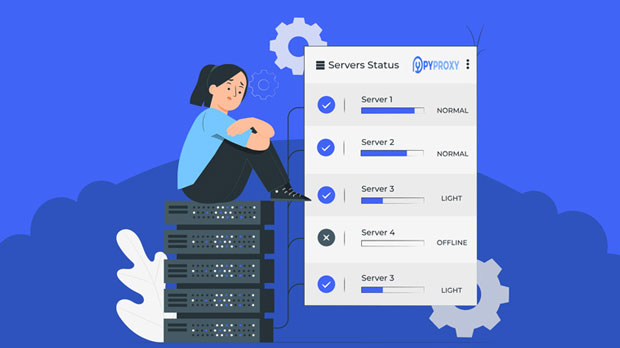In high-concurrency environments, where the volume of simultaneous requests is exceptionally high, the performance of proxies becomes critical. PYPROXY, a specialized proxy solution, aims to handle these situations effectively by utilizing a dedicated data center proxy infrastructure. This article outlines an optimization strategy for PYPROXY proxies in such environments. The solution focuses on performance enhancement, reliability, scalability, and security, ensuring efficient data flow even during peak traffic periods. By analyzing each layer of the solution in detail, we can provide a robust plan for optimizing PYPROXY's performance and meeting the demands of modern high-concurrency applications. Understanding High-Concurrency EnvironmentsHigh-concurrency environments are characterized by a large number of simultaneous user requests that need to be processed by a system, often in real-time. This can occur in industries such as online gaming, financial services, e-commerce, or streaming platforms, where large volumes of traffic are generated at any given moment. For proxy services like PYPROXY, which act as intermediaries between clients and the target servers, ensuring smooth data transmission while maintaining low latency is crucial. Without optimization, the system might experience bottlenecks, increased response times, or even service downtime.Challenges in High-Concurrency Proxy EnvironmentsThe main challenges faced by proxy systems in high-concurrency environments include:1. Latency and Response Time: As the number of requests increases, the time taken for proxies to respond to client requests also increases. This leads to delays, which can affect the end-user experience negatively.2. Scalability Issues: A proxy system must be able to scale horizontally to handle an increasing load. Without proper scalability mechanisms, proxies can quickly become overwhelmed, causing performance degradation.3. Load Balancing: Ensuring an even distribution of requests across available resources is critical. Poor load balancing can lead to some servers being overwhelmed while others remain underutilized.4. Security Threats: High-concurrency environments are often targeted by malicious actors. Ensuring the security of proxy services from DDoS attacks, data breaches, and unauthorized access is a critical concern.5. Resource Allocation: Efficiently managing resources, including bandwidth, CPU, and memory, is crucial in handling large-scale proxy operations. Inefficient resource allocation leads to slower performance and higher operational costs.Optimization Techniques for PYPROXY in High-Concurrency EnvironmentsTo tackle these challenges, several optimization strategies can be applied to PYPROXY’s dedicated data center proxy solution.1. Load Balancing and Traffic DistributionOne of the first steps in optimizing proxy services for high-concurrency environments is implementing a robust load balancing mechanism. Load balancing ensures that incoming requests are distributed evenly across multiple proxy servers, preventing any single server from being overwhelmed. Various load-balancing techniques, such as round-robin, least connections, or IP hash-based methods, can be employed depending on the system’s needs.By using load balancers, PYPROXY can increase system throughput, reduce response times, and prevent server overload, ensuring high availability and reliability of the proxy services.2. Horizontal ScalabilityTo effectively handle large volumes of simultaneous connections, PYPROXY’s architecture should be designed with horizontal scalability in mind. This means adding more servers as demand increases. PYPROXY can utilize cloud-based infrastructures that allow for auto-scaling based on the load, ensuring that additional proxy instances are brought online as needed.Horizontal scaling reduces the risk of service degradation during peak loads and ensures that the system remains performant even as traffic fluctuates.3. Caching and Content Delivery Network (CDN) IntegrationIn high-concurrency environments, caching frequently requested data can significantly reduce load on proxy servers. By storing a cache of commonly requested content, the system can serve these requests directly from the cache, bypassing the need to forward requests to the target server. This not only improves response times but also reduces the overall traffic between clients and the data center.Additionally, integrating a Content Delivery Network (CDN) can further enhance performance. A CDN can distribute the content across geographically dispersed servers, reducing latency and improving access speed for users around the globe.4. Performance Monitoring and Adaptive Traffic ManagementContinuous performance monitoring is essential for identifying potential bottlenecks in the proxy service. Implementing an adaptive traffic management system allows PYPROXY to respond dynamically to changes in load and optimize traffic routing in real-time. By adjusting parameters like request frequency limits, connection timeouts, and buffer sizes based on current system performance, the proxy service can adapt to fluctuating traffic volumes without compromising on performance.Advanced monitoring tools can also alert administrators to any unusual activity, enabling proactive measures to mitigate performance degradation or security threats.5. Security EnhancementsIn high-concurrency environments, security becomes even more critical, as the large volume of requests increases the risk of DDoS attacks, data breaches, and other malicious activities. PYPROXY should implement multiple layers of security measures to protect against these threats:- Traffic Anomaly Detection: Using machine learning and AI to detect abnormal traffic patterns can help identify and mitigate DDoS attacks in real time.- Encryption and Authentication: Ensuring that all data passed through the proxy is encrypted and securely authenticated will protect sensitive information from unauthorized access.- Rate Limiting: By enforcing rate limiting, the proxy can prevent abuse and ensure that no single client or malicious actor can overwhelm the system with excessive requests.6. Resource Optimization and Efficient Hardware UsageEfficient resource allocation is essential for maintaining the optimal performance of PYPROXY’s dedicated data center proxies. This involves optimizing the use of CPU, memory, and bandwidth. By deploying high-performance servers with specialized hardware for network traffic handling and optimizing the software stack to efficiently handle multiple concurrent connections, the proxy service can achieve faster response times and lower operational costs.Additionally, load testing and performance tuning can help identify the ideal server configuration for specific workloads, ensuring that resources are fully utilized without overprovisioning.Optimizing PYPROXY for high-concurrency environments requires a multi-faceted approach that addresses key performance, scalability, security, and resource management challenges. By implementing strategies such as load balancing, horizontal scalability, caching, performance monitoring, and security enhancements, PYPROXY can provide a reliable and efficient proxy service that meets the demands of modern high-concurrency applications. These optimization techniques ensure that PYPROXY delivers fast, secure, and highly available proxy services, even during periods of peak traffic.
Nov 13, 2025


































































